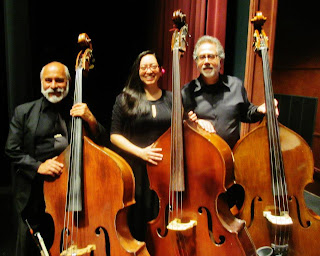 |
| Three bassists from our last concert. |
Tuesday is the official weekly rehearsal night. As it
approaches 7 p.m., cars begin to arrive at Creekside Middle School. The
musicians carry, and sometimes roll, their instruments into the school and down
the hall. On the right, the band room door is usually open and folks stream in
and go to their customary places.
The band room, with its tall ceiling, lockers on all four
sides, and whiteboards, is used by the middle school for its music programs.
It’s already set up with chairs and stands, but they may not be arranged
perfectly, so there is some scraping and carrying before instruments come out
of their cases and tuning begins. Many of the musicians have been playing in
the group for years together, so there is plenty of friendly banter and telling
of jokes, including some hilarious musical ones that are the specialty of a
certain clarinetist.
Normally, music director Josh Cohen is already there, and he
gets ready, sometimes passing out music for new pieces the orchestra will work
on later. However, slowly, he is training the group to use the Internet to
download and print out the music at home before coming to rehearsal.
By 7:15 p.m., it’s time to start. The oboist plays a piercing
“A” and the other musicians match it, bringing the group into tune. Then, with
a wave of his slender baton, the orchestra’s seasoned leader gets the 30 to 40
musicians under way.
When you attend a concert, you hear the pieces in their
entirety, one after the other, but that’s not how the orchestra rehearses them.
There are frequent stops and lots of repetition to get the sound just right.
And it takes a couple of months to do it. Luckily, the sheet music is marked
with measure numbers or a rehearsal number or letter to make sure everyone
starts in the same place.
Sometimes, just the strings will play, and the winds sit and
listen, thinking about how their parts fit in. Then, it’s their turn to play
and the strings listen. Sometimes one section plays. Normally, before moving on
to another piece—or a movement within it—the group plays the section through
from start to finish. Knowing what to play is important, but knowing how it
relates to the entire orchestra is essential to having a good concert.
The group works on the tempo—how fast or slow it goes. There
are frequent changes in dynamics—how loud or quiet it is. Dynamics are
especially tricky. The entire orchestra may change volume level together or
some instruments may play louder to stand out, for example, during a solo. The
entire orchestra or sections can change volume slowly, too. It’s very important
to have these changes learned by concert time.
Josh, with support from the advisory board, made up of several
members of the orchestra, plans the programs in advance. It can take time, and
often costs money, to borrow all of the sheet music to a piece of music. It can
cost several hundred dollars if it’s not available in public domain.
At about the halfway point, Josh calls a break and people go
back to chatting and heading down the hall to the restrooms. Then, it’s back to
work. “Let’s hear the violins and cellos at measure 147,” says Josh, in his
friendly tone. Although he controls the musicians, Josh doesn’t holler at or
berate them. That’s part of why the musicians keep coming back for more each
season. The group meets from September to May, echoing the school year. As a
part of Castro Valley Adult and Career Education, that’s natural.
It’s important to practice your part to learn the nuances and
get it smooth for the show. I keep my bass in a stand in my dining room, so I
can pick it up every day and work on the concert pieces. There isn’t time in
the group rehearsal to do this.
The upcoming concert on Sunday, May 26, 2013 at 2:00 p.m.
features four works, including Reinecke’s Harp Concerto. It takes place at the
Castro Valley Center for the Arts at 19501 Redwood Road, Castro Valley. Adult
admission is $10, seniors and children 13-18 are $5 and kids 12 and under get
in for free.







No comments:
Post a Comment